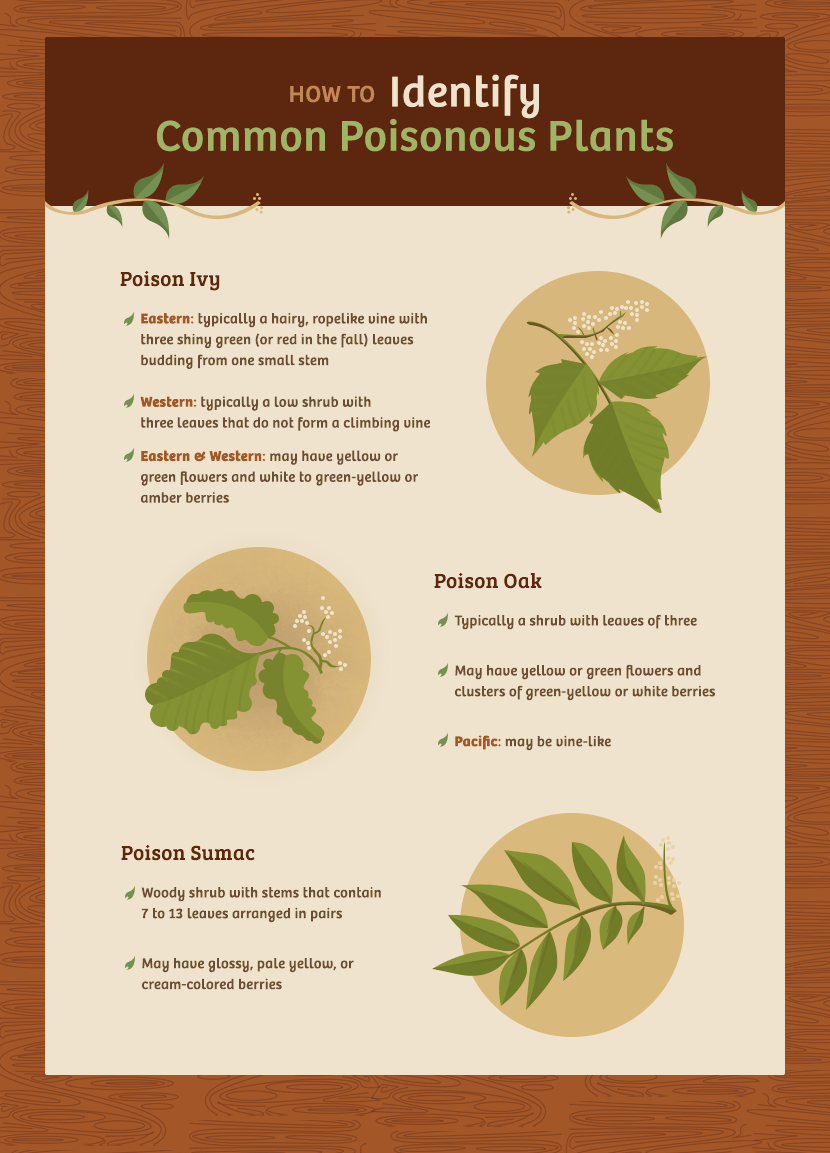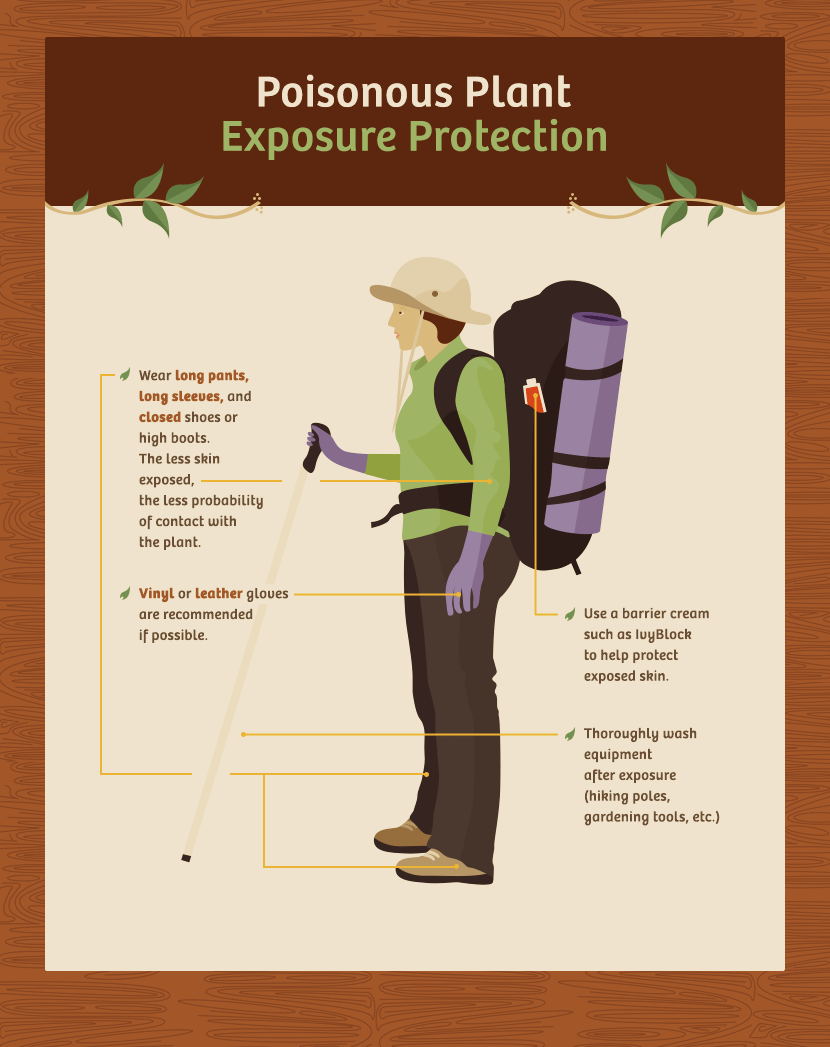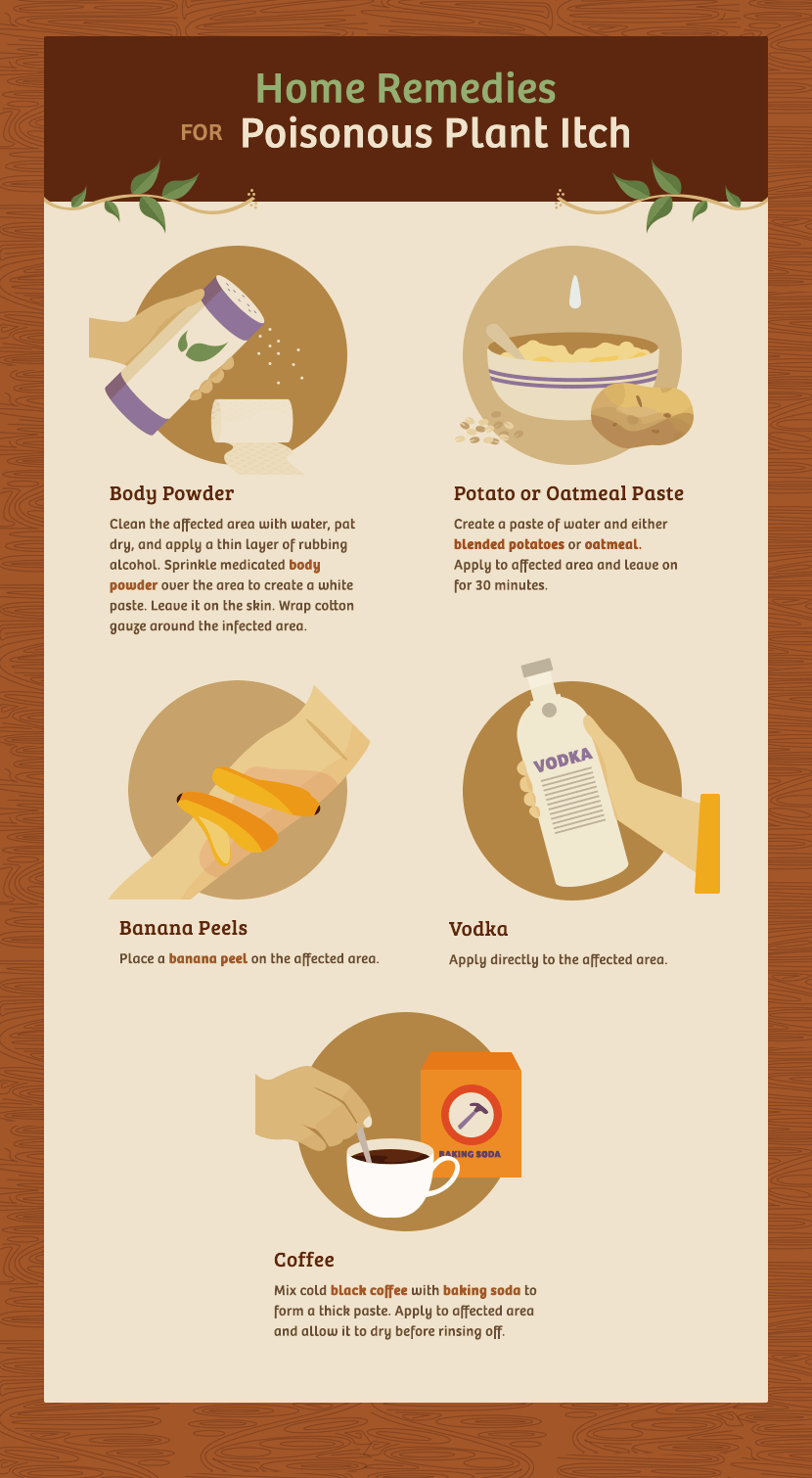How to Prevent Contact With Poisonous Plants
One surefire way to ruin a picture-perfect outing is to come in contact with a poisonous plant and suffer the consequences: unbearably itchy skin rash, headaches, dizziness, nausea – the list goes on and on. How can you avoid these poisonous green party poopers? It’s all about knowing what to look for.
The Poison behind the Plant
Although a number of plants can provoke a skin reaction, three major poisonous culprits tend to cause an irritating skin rash: poison ivy, poison oak, and poison sumac.
All three of these plants contain an oily sap called urushiol. This sap is located in the plant’s leaves, stems, and roots, and it is quite sticky, so it easily adheres to skin, clothing, pet fur, gardening tools, and more. Urushiol is so strong that if contaminated objects aren’t properly cleaned, the oil can cause a reaction even later. That’s one reason why it’s so important to thoroughly clean camping equipment when a trip is over.
After it comes in contact with skin, urushiol triggers an allergic reaction that usually results in a red, itchy rash called allergic contact dermatitis. Although this is rarely anything more than a bothersome inconvenience, the severity of the reaction depends on the amount of contact with the plant. The initial rash can spread within hours of exposure, or it may take several days to appear. Typically, the first sign of a reaction appears in the form of straight red lines that gradually become more itchy and swollen. In some cases, blisters may appear. (Contrary to popular belief, the fluid inside the blisters is not contagious.http://www.mayoclinic.org/diseases-conditions/poison-ivy/basics/symptoms/con-20025866)
How to Identify Poisonous Plants
When it comes to identifying poisonous plants, the old adage, “leaves of three, let it be” may be a good rule of thumb, but it’s not exactly foolproof. Both poison oak and poison ivy have three leaves. Depending on the exact species, time of year, location, and other factors, the leaves can have distinct textures and colors. Poison sumac is typically a cluster plant with up to 13 leaves.
Now that we have slightly disproved the three-leaf theory, we can move on to identifying local varieties throughout the seasons. All three plants can be found in most areas of the United States, excluding Alaska, Hawaii, and the deserts of the Southwest. Depending on the location, each plant can have a distinct appearance.
Poison Ivy
Poison ivy is a prolific plant that grows well along road edges or in areas that are not heavily trafficked. It’s found mainly in the Eastern, Midwestern, and Southern regions, where it is fairly widespread thanks to the birds and deer that eat poison ivy berries.
Although you can generally identify poison ivy by its three leaves, it has a chameleon-like quality that turns the leaves different colors and textures depending on location. The leaves can have dull or glossy leaflets with smooth or jagged edges. Sometimes the leaves are hairy, and sometimes they are not.
When trying to avoid poison ivy, it is essential to be aware of its regional appearance. In the East, Midwest, and South, poison ivy often grows as a vine, but in the northern regions, it grows as a shrub that can spread along the ground and climb on low plants, trees, street signs, telephone poles, and more.
Eastern poison ivy is typically recognized by its hairy, rope-like, vine appearance with three shiny green (red in the fall) leaves budding from one small stem. Western poison ivy is typically a low shrub with three leaves that does not form a climbing vine.
Typically, poison ivy leaves are reddish in spring, green in summer, and yellow, orange, or red in fall. In the spring, poison ivy “blooms” with yellow or greenish-white flowers and light yellow or amber berries, which ripen in the summer.http://msue.anr.msu.edu/news/identifying_poison_ivy_isnt_always_easy_to_do
Poison Oak
Poison oak is most commonly found in the western United States, although it can also grow in the eastern states. It is rarely found in the Midwest. It can grow as a vine or a low-lying shrub, and its leaves are typically shaped similar to oak leaves.
Mature poison oak leaflets are a dull green and are typically more jagged or “toothed” than poison ivy. Like poison ivy, it has leaves of three, but unlike poison ivy, poison oak leaflets have hairs on both sides. The leaves can have yellow or green flowers and clusters of green-yellow or white berries.
Poison Sumac
Poison sumac (also known as thunderwood) is less common than poison ivy and poison oak. The plants grow as woody shrubs or small trees that can grow up to 30 feet in dense, swampy areas, such as Florida and other parts of the Southeast. Although not very common in the north, it can be found in extremely wet, wooded areas along the northeastern United States and even into Canada.
Poison sumac stems usually have no hair and 7 to 13 leaves per stem that are 2 to 4 inches long. The leaves have smooth edges and pointed tips, and they usually have a red stem that stretches along the leaflets. The plant flowers with greenish clusters that can sprout glossy, pale yellow or cream-colored berries.
Although less common, poison sumac is thought to be more virulent than both poison ivy and poison oak. Often, the reaction caused by sumac contact is more intense, resulting in a more painful, long-lasting rash and swelling.http://www.cdc.gov/niosh/topics/plants/

Home Remedies for Poisonous Plant Exposure
Even if you hone your poisonous plant prevention skills, your possibility of being exposed to one of these plants while hiking or gardening is still fairly high. In fact, it’s not uncommon to be exposed to the sticky sap through contact with camping equipment or even a pet’s fur. In addition, airborne contact is also possible because all three plants release particles of urushiol into the air, which can penetrate the skin, eyes, nose, throat, or respiratory system.https://www.aad.org/dermatology-a-to-z/diseases-and-treatments/m---p/poison-ivy/who-gets-causes
If you know you will be in an area known to have poison ivy, oak, or sumac, it’s best to:
- Wear long pants, long sleeves, and closed shoes or high boots. The less skin exposed, the less probability of contact with the oil.
- Wear vinyl or leather gloves if possible.
- Use a barrier cream, such as IvyBlock, to help protect exposed skin.
- Thoroughly wash equipment (hiking poles, gardening tools, etc.) after exposure.
If you do come in contact with one of the plants, isolate the infected area. The primary symptom is a red rash that, for most people, is typically not severe or life threatening. In most cases, the rash can last anywhere from 10 days to 3 weeks, depending on the treatment used. Scratching the itchy rash doesn’t necessarily cause it to spread, but it can prolong the healing process. Therefore, it’s recommended that you treat the rash as soon as symptoms appear.http://www.webmd.com/skin-problems-and-treatments/guide/understanding-poison-ivy-oak-sumac-basics

Poison Plant First Aid
As soon as you notice signs of contact with a poisonous plant, clean the area with rubbing alcohol or, better yet, a specialized poison-plant skin wash. Alternatively, you can use most degreasing soaps or detergents to clean the infected area. Rinse frequently with plenty of water so the solution you use does not dry out on the area, which can spread the urushiol to other parts of the body (such as the hand you are using to treat the infected area).
After cleaning the area, apply wet compresses, calamine lotion, or hydrocortisone cream to the skin to reduce itching and blistering. An antihistamine, such as diphenhydramine (Benadryl), can help relieve the itch.
Of course, coming into contact with a poisonous plant is quite common when you participate in outdoor activities, including hiking or gardening. However, for those times you’re caught away from the medicine cabinet, a few home remedies can ease itchy discomfort from these poisonous plants.http://camping.wonderhowto.com/how-to/top-5-home-remedies-for-treating-poison-ivy-and-poison-oak-rashes-0138259
1. Body Powder
Clean the infected area with water, pat dry, and apply a thin layer of rubbing alcohol. Then, sprinkle a bit of a medicated body powder over the area to create a white paste. Leave it on the skin and wrap cotton gauze around the infected area to isolate the rash.
2. Banana Peels
Banana peels contain a number of healing antifungal, antibiotic, and enzymatic properties that can be useful for rash relief. If you don’t have access to alcohol or body power, place a banana peel on the infected area as a temporary solution. The medicinal properties of the peel may not cure the rash, but it can offer some itch relief.
3. Potato/Oatmeal Pastes
Some foods, including potatoes and oatmeal, have anti-inflammatory properties that can help treat a number of inflammatory conditions, including sunburn. After coming in contact with poisonous plants, both foods can help treat an irritating reaction.
First, wash the potato and peel it. Make a thick paste by grinding the potato in a blender. You may need to add a little bit of water, but avoid making the paste too runny. Then, add the paste to the rash and cover it with a clean cloth or large bandage. Leave the paste on for 30 minutes to one hour and wash off. Repeat if necessary.
To make an oatmeal paste, mix one cup of oatmeal with 1/2 teaspoon of salt and 1/4 cup of lukewarm water. Add more water as necessary to make the paste thick enough to slather on the skin. Apply the paste to the rash twice a day, leaving it on for about 30 minutes.
If the rash is fairly large, consider a warm bath in colloidal oatmeal. Because colloidal oatmeal is a finely ground powder, it does not sink to the bottom of the bathtub, providing more relief for a larger rash.
4. Vodka
If you’re out of the aforementioned products, high-proof alcoholic beverages can act as a substitute for rubbing alcohol. You can sterilize a rash by applying the alcohol directly to the affected area. If you realize you have come in contact with a poisonous plant and apply the vodka quickly, you may be able to wash away the irritant from the skin and avoid the subsequent itchiness.
5. Coffee
Coffee contains chlorogenic acid, which acts an anti-inflammatory and may help soothe the irritation caused by poisonous plants. To make a coffee paste, mix cold black coffee with a few teaspoons of baking soda. Blend until the mixture forms a thick paste. Cover the entire affected area with the paste, and then allow it dry on the skin. Repeat two or three times a day.

Poisonous Plant First-Aid Kit
While most first-aid kits contain the basics to clean a simple wound, people who are especially sensitive to poisonous plants may want to pack their kits with some extra products.
In addition to rubbing alcohol and cotton gauze, consider a few packets of anti-itch ointment or hydrocortisone anti-itch cream. You can also find products specifically made for poison oak or ivy relief. Carry calamine lotion and an antihistamine, such as Benadryl, in first-aid kits in case of an allergic reaction.
Although the reaction caused by coming in contact with poison ivy, oak, or sumac is rarely severe enough to go to the hospital, you should keep a few exceptions in mind. If the rash spreads to the eyes, face, or genitals, seek professional medical attention immediately. Call 911 or go to the hospital if the rash is accompanied by any of these symptoms:
- Severe swelling
- Labored breathing
- Temperature over 100° Fahrenheit
- Blisters that ooze pus
- Extreme tenderness
If the rash does not improve within a few weeks, visit a medical professional to seek further treatment.
Coming into contact with poisonous plants can put a serious damper on a camping or hiking trip. It can also be extremely dangerous. Know what to look for and stock your first-aid kit with products specifically made for poison oak, sumac, and ivy relief. Remember that the first line of defense is prevention.
Embed the article on your site

